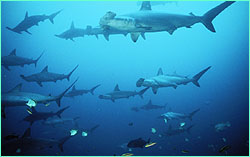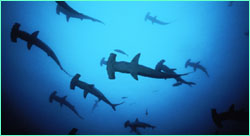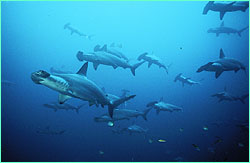 |
 |
 |
Part 2 (back to Part 1) NOVA: What do you think has made you a successful shark researcher? Klimley: Well, for one thing, I don't just study sharks, I study their behavior. All the things they do, their capabilities. And I've had to change people's minds a bit. When I wrote articles about how white sharks can communicate, even scientists parodied my study. How could this stupid feeding machine communicate? If you want a job that pays well, you certainly wouldn't do what I did in my early years—you know, be the first person to do things—because you're kind of like a struggling artist. What you're doing is controversial, so you're not publishing a lot of papers. But therein lies the excitement. NOVA: So why does the hammerhead have such an oddly shaped head? Klimley: I think the head has two functions. Juveniles locate prey buried in the sand by using their electro-receptors. Called ampullae of Lorenzini, these are scattered across the underside of the rostrum. And the wider the shape the more area covered per movement. Now, adults don't feed on buried prey but on fish and squid. For them, I think the head has something to do with their ability to navigate through the open ocean.
Klimley: Well, they seem to orient to minute magnetic patterns of intensity. The seafloor has north-south bands of strong and weak magnetization, which are created during the secretion of ocean crust. And seamounts like that at Cocos Island have dipoles associated with them, because they're generally volcanic. So hammerheads could use these bands, in a sense, as roads that go north-south, and the dipoles as landmarks. (It's like the reverse of our cities and suburbs: the sharks rest at the seamount during the day and go out at night into the surrounding areas to forage.)
NOVA: And you've tracked where they go at night, right? Klimley: Yes, with ultrasonic telemetry. When the sun sets, they leave the seamount either in small groups or individually. They travel up to 12 miles and stop at a certain time, say 1 a.m. Later in the morning they turn around and generally come back along the same path. The sensors also transmit information about heading, dive depth, water temperature, and the like, so we can not only track movement but also learn about behavior and the environment that they're orienting in. The heading sensor has shown that they move with the directionality of a car moving on a highway.Being in the ocean a lot and knowing the great variability in currents, speeds, and directions, it stunned me that the animals could do that.
Klimley: That's not known. Animals generally have elements of what we do, but if you try to say whether they do it exactly, the answer is no. "Sleep-like" would be more like it. Many sharks remain on the bottom in a quiescent state. Hammerheads rest during the day, though they are continually moving and socially interacting. Continue: How fast do they swim? Cocos Island | Sharkmasters | World of Sharks | Dispatches E-mail | Resources | Site Map | Sharks Home Editor's Picks | Previous Sites | Join Us/E-mail | TV/Web Schedule | About NOVA Watch NOVAs online | Teachers | Site Map | Shop | Search | To Print PBS Online | NOVA Online | WGBH © | Updated June 2002 |
 Schooling hammerheads
navigate near Cocos Island.
Schooling hammerheads
navigate near Cocos Island.
 Hammerheads orient using the Earth's
magnetic field.
Hammerheads orient using the Earth's
magnetic field.
 Klimley has helped elucidate hammerhead night
life.
Klimley has helped elucidate hammerhead night
life.
 While at Cocos, hammerheads appear to be in a
somnolant state.
While at Cocos, hammerheads appear to be in a
somnolant state.